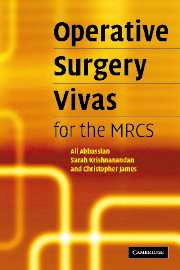Book contents
- Frontmatter
- Contents
- Preface
- 1 The elective repair of an abdominal aortic aneurysm
- 2 Adrenalectomy
- 3 Amputation (below knee)
- 4 Anorectal abscesses, fistulae and pilonidal sinus
- 5 Appendicectomy
- 6 Principles of bowel anastomosis
- 7 Breast surgery
- 8 Carotid endarterectomy
- 9 Carpal tunnel decompression
- 10 Central venous cannulation
- 11 Cholecystectomy (laparoscopic)
- 12 Circumcision
- 13 Colles' fracture (closed reduction of)
- 14 Compound fractures
- 15 Dupuytren's contracture release
- 16 Dynamic hip screw
- 17 Fasciotomy for compartment syndrome
- 18 Femoral embolectomy
- 19 Femoral hernia repair
- 20 Haemorrhoidectomy
- 21 Hip surgery
- 22 Hydrocele repair
- 23 The open repair of an inguinal hernia
- 24 Laparotomy and abdominal incisions
- 25 Oesophago-gastroduodenoscopy
- 26 Orchidectomy
- 27 Parotidectomy
- 28 Perforated peptic ulcer
- 29 Pyloric stenosis and Ramstedt's pyloromyotomy
- 30 Right hemicolectomy
- 31 Skin cover (the reconstructive ladder)
- 32 Spinal procedures
- 33 Splenectomy
- 34 Stomas
- 35 Submandibular gland excision
- 36 Tendon repairs
- 37 Thoracostomy (insertion of a chest drain)
- 38 Thoracotomy
- 39 Thyroidectomy
- 40 Tracheostomy
- 41 Urinary retention and related surgical procedures
- 42 Varicose vein surgery
- 43 Vasectomy
- 44 Zadik's procedure
7 - Breast surgery
Published online by Cambridge University Press: 16 October 2009
- Frontmatter
- Contents
- Preface
- 1 The elective repair of an abdominal aortic aneurysm
- 2 Adrenalectomy
- 3 Amputation (below knee)
- 4 Anorectal abscesses, fistulae and pilonidal sinus
- 5 Appendicectomy
- 6 Principles of bowel anastomosis
- 7 Breast surgery
- 8 Carotid endarterectomy
- 9 Carpal tunnel decompression
- 10 Central venous cannulation
- 11 Cholecystectomy (laparoscopic)
- 12 Circumcision
- 13 Colles' fracture (closed reduction of)
- 14 Compound fractures
- 15 Dupuytren's contracture release
- 16 Dynamic hip screw
- 17 Fasciotomy for compartment syndrome
- 18 Femoral embolectomy
- 19 Femoral hernia repair
- 20 Haemorrhoidectomy
- 21 Hip surgery
- 22 Hydrocele repair
- 23 The open repair of an inguinal hernia
- 24 Laparotomy and abdominal incisions
- 25 Oesophago-gastroduodenoscopy
- 26 Orchidectomy
- 27 Parotidectomy
- 28 Perforated peptic ulcer
- 29 Pyloric stenosis and Ramstedt's pyloromyotomy
- 30 Right hemicolectomy
- 31 Skin cover (the reconstructive ladder)
- 32 Spinal procedures
- 33 Splenectomy
- 34 Stomas
- 35 Submandibular gland excision
- 36 Tendon repairs
- 37 Thoracostomy (insertion of a chest drain)
- 38 Thoracotomy
- 39 Thyroidectomy
- 40 Tracheostomy
- 41 Urinary retention and related surgical procedures
- 42 Varicose vein surgery
- 43 Vasectomy
- 44 Zadik's procedure
Summary
When should a mastectomy be performed in preference to breast conserving surgery?
A mastectomy is preferred to breast conserving procedures in:
Multifocal or widespread disease
Breast cancer in men
Treatment of recurrence after breast conservation surgery.
Relative indications include:
A large tumour in a small breast
Tumour close to the nipple.
What is the arterial blood supply to the breast?
Branches from the anterior intercostal arteries (internal thoracic artery) supply the medial part of the breast.
Laterally a network of anastomosis from branches of the axillary artery provide the blood supply. These include the lateral thoracic artery, pectoral branch of the thoracoacromial artery and the superior thoracic artery.
What different forms of mastectomy do you know? What do they involve?
Simple mastectomy: This refers to the excision of the whole breast, its axillary tail, the nipple and any involved overlying skin but preserving the pectoralis fascia. Axillary surgery is not performed.
Radical mastectomy: This is the excision of the entire breast tissue, pectoralis major and minor muscles, and a complete axillary clearance.
Patey radical mastectomy: In this procedure pectoralis major muscle is spared but pectoralis minor is removed to allow a complete axillary clearance.
What different types of axillary surgery do you know?
Axillary lymph node sampling: This refers to the removal of at least four prominent axillary lymph nodes. If the nodes are positive then further treatment in the form of radiotherapy or axillary clearance is offered to the patient.
Axillary clearance: This refers to the complete clearance of the axillary lymph nodes and is associated with significant morbidity.
- Type
- Chapter
- Information
- Operative Surgery Vivas for the MRCS , pp. 23 - 26Publisher: Cambridge University PressPrint publication year: 2006



